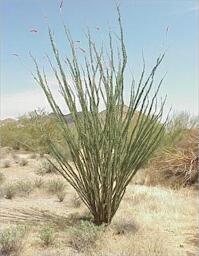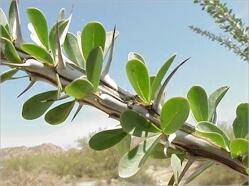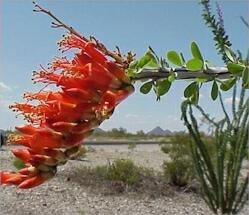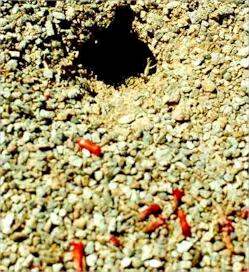OCOTILLO (Fouqueiria
splendens) and ADAM'S TREE (F.
diguetii) Ocotillo is very closely related to the boojum tree but has a quite different growth form. It produces many slender woody stems from the base of the plant just below ground level. These stems are spiny and leafless for major parts of the year, but in response to rain the plants can sprout thin leaves within 3 days. These leaves turn brown and are shed when water is scarce. The younger stems have a grey, waxy coating but underneath this is photosynthetic tissue which allows the plants to synthesise sugars even when the leaves have dropped. The details of the spines and leaves are interesting. The first leaves to be produced on a stem have a pronounced leaf stalk (petiole) and midrib. When these leaves die the petiole and part of the midrib remain on the plant and become woody to form the spines (see image above). Then very short (almost invisible) branches arise at the base of each spine, and these branches produce leaves repeatedly in response to periods of rainfall. In other words, in the image above we are seeing spines (the remains of the first leaves to be produced) and fresh leaves which develop periodically from the almost invisible branches at the base of the spines. In spring the plants produce flower spikes at the ends of the stems. The individual flowers are bright red and tubular - two features that are characteristically associated with pollination by hummingbirds. It is certainly true that hummingbirds rely heavily on the nectar of ocotillo flowers to sustain them during their annual migration northwards from Mexico to the mountains of the western USA. But hummingbirds may not be the only (or even the main) pollinators of ocotillo. Large carpenter bees can be equally effective when they crawl over the inflorescences and bite through the flower tubes to get the nectar. The flowers also are eaten by ants and antelope ground squirrels.
Ocotillo is very widely distributed in the warm desert regions of southwestern USA and Mexico, including the Sonoran, Chihuahuan and Mojave Deserts. It extends east as far as Central Texas. This wide distribution contrasts with the very restricted distribution of the boojum tree, its close relative, which is found only in parts of Baja California. The difference is probably related to the fact that boojum is a stem succulent and requires substantial water (often provided by mist-laden air), whereas ocotillo is quite drought-tolerant. In the peninsula of Baja California and parts of mainland Mexico there is another member of the family Fouquieriaceae, termed Adam's tree (Fouquieria diguetii). It strongly resembles ocotillo, but is denser and the stems arise from a short trunk above ground level. Also, the leaves are thicker and the flower spike is smaller, often with more pink-coloured flowers.
In some parts of its range, Adam's tree becomes much taller and develops a true tree-like form, with a major trunk and branching habit. |







